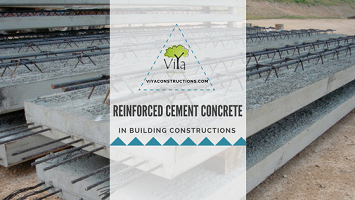The layperson is quite unfamiliar with the materials in use in the field of construction. Though it is not necessary to dig into the details of all the materials used, it wouldn’t hurt to have a fair idea about the major components used in building construction. The knowledge of such aspects helps in making smart and pocket-friendly choices. Reinforced Cement Concrete (RCC) is amongst the most commonly recognizable terms related to building construction. Let us look in detail to understand RCC in building construction, the significance of the term “reinforced’’ in RCC and its properties and advantages.
RCC or Reinforced Cement Concrete
What is RCC in Building Construction?
Cement Concrete used in building construction is usually obtained by hardening a mixture of cement, sand, gravel and water in predetermined proportions. The properties of concrete vary widely depending on the quality and proportion of the ingredients used in the mix. Concrete is good in resisting compression but is very weak in resisting tension. The solution for this is to add steel to the combination. Since the bond between steel and concrete is strong, it is possible to place steel bars at tensile zones of the structure. This practice is called steel reinforcement and after the reinforcement, the concrete is called Reinforced Cement Concrete (RCC).
Requirements of Good RCC
The composition of RCC must be such that it meets the requirements which assure its quality and sustainability. It must be capable of resisting expected tensile, compressive, bending and shear forces. There should be a proper cover to reinforcement such that it prevents corrosion. It should not develop hair cracks beyond the permissible limit. It should insulate noise and heat completely. It’s structure should be such that it supports any load, ensures durability and also provides good control over the cross-sectional requirements. Thus, the concrete cubes are prepared, cured and tested in accordance with these requirements.
Advantages of using RCC in building construction
The use of RCC in building construction is quite advantageous. RCC has a stable structure due to good binding between steel and concrete and therefore is more durable. It has minimal chance of rusting and buckling. Concrete structures are aesthetically good and do not require cladding. Moreover RCC is resistant to fire and other climate changes. Furthermore it’s repairing cost is almost nil. In addition, working on it does not require any specific expertise.
Procedure of RCC Slab Casting
The work procedure of slab casting involves marking the slab, placing the reinforcement, performing formwork for the slab and finally, placing the concrete.
The machinery used for slab casting are:
- Batching plant.
- Transit mixer
- Concrete pump
- Vibrators
- Chute and CI Pipes
The materials required for slab casting are:
- Cement conforming to IS 8112,12269.
- Aggregates conforming to IS 383
- Mild Steel & Medium Tensile Bars Conforming to IS 432.
- Admixtures used should comply with IS 9103
- Water should be tested for its contents based on IS 3025 part 22&23
Before the production and placement of concrete, it is necessary to ensure that the stock of materials is sufficient to start the concrete. The purchase department confirms that no stop in concreting occurs on this account by keeping track of the stock. Before beginning the procedure, it is necessary to check all plants and machinery and make them in working condition.
The concrete produced can be of different grades.
The grade of concrete is specified based on the following information:
- Type of mix, design or nominal
- Grade designation
- Type of cement
- Maximum size of aggregates
- Minimum cement content
- Maximum water – cement ratio
- Workability
- Maximum temperature of placing
- Method of placing
- Degree of supervision.
The batching plant can produce concrete of any grade. The batching of concrete can be done by either of the two techniques: volumetric batching or weight batching. From the batching plant, it is directly pumped to the location of concrete placement through the pipeline. Thorough mixing is essential for producing uniform, high-quality concrete. Mixing can be either by hand or machine. Mixing ensures that the cement water paste completely covers the surface of aggregates and fills all the spaces between them.
The pipelines should be placed in such a way that it does not come in the way of the reinforcement placed over the slabs. Temporary triangular supports at about 1.5 feet high are used for this purpose. These temporary supports absorb the to and fro movements of the pipeline.
Extra props like gunny bags are also stocked below the slab to provide additional support in case of any failure of supports. Carpenters along with supervisors shall monitor and inspect the behavior of supports below the slab during the casting. Joints are usually the common source of weakness, therefore it is desirable to avoid them. After placing the concrete, curing follows.
Curing
Curing is the process of keeping concrete under a specific environmental condition to maintain an environment of humidity around freshly placed concrete till the process of hydration is relatively complete. Hence curing should start immediately after thumb set of the concrete is laid. Hessian cloth /plastic is used to cover the set concrete so as to reduce moisture evaporation from the concrete during hardening. This not only minimizes shrinkage of crazy cracks but also keeps the concrete from drying too rapidly. Curing thus completes the work procedure of RCC slab casting.
Call us NOW to know more about RCC in building construction or to get a free quote.
